HDZ Whip: Shopping Hours to be Adjusted to Seasonal Activities
ZAGREB, 6 July, 2021 - The whip of the ruling HDZ, Branko Bačić, said on Tuesday the parties of the parliamentary majority supported amendments to the Trade Act, adding that shopping hours would be adjusted to seasonal activities.
Parliament will debate the amendments in the autumn.
Speaking to the press after a meeting of the parliamentary majority, Bačić said they talked about the problem of restricting shopping hours until 9 pm, notably during the summer tourist season, when they have the biggest turnover.
"We must take account of the international convention on the rights of shop workers to daily and weekly rest," Bačić said, adding that it was important to reach as much consensus as possible with those to whom the law applied.
"We'll take into account rest and adjusting shopping hours to seasonal activities across Croatia. We'll give employers the possibility to decide how many Sundays in the year they will work."
Reformists president Radimir Čaćić pushed for as much flexibility regarding shopping hours as possible, saying that family firms should be allowed to work when and how long they wanted.
He praised the proposal by Silvano Hrelja of the Croatian Pensioners Party "not to define shopping hours but the number of non-working hours, to say that a shop must have eight non-working hours. That's very good as it allows everyone to organise themselves as they wish."
Bačić said the parliamentary majority also talked about plans to make job-keeping payments in sectors affected by the epidemic conditional on worker vaccination, adding that the purpose was to stimulate employers with a high vaccination rate "for contributing to curbing the epidemic as soon as possible."
He said the government was not shifting responsibility to employers and that measures to that effect would be agreed by the government, the social partners and legal experts, taking Croatia's economic interest into account.
For more about politics in Croatia, follow TCN's dedicated page.
Croatian Souvenirs to Remember Your Perfect Holiday in Croatia
July 6, 2021 - Ashleigh Brilliant once said, "Keep some souvenirs of your past or how will you ever prove it wasn't all a dream?" Here are some authentic Croatian souvenir ideas to keep your dreamy holiday memories in Croatia alive.
Traditional handmade lace
 By foto Suradnik13 - Own work, CC BY-SA 4.0, https://commons.wikimedia.org/w/index.php?curid=4674646
By foto Suradnik13 - Own work, CC BY-SA 4.0, https://commons.wikimedia.org/w/index.php?curid=4674646
Lacemaking in Croatia is a traditional craft that began in the Renaissance era and is listed under UNESCO's Intangible Cultural Heritage of Humanity. The Croatian laces are notable among others due to their unique materials, patterns, and designs. There are several lacemaking traditions in Croatian but the top ones are needle lacemaking in Pag, bobbin lacemaking in Lepoglava, and agave lacemaking in the island of Hvar. Pag needle lace is made by needlepoint, patterned with various geometrical motifs most especially, the spider web. Lepoglava bobbin lace uses flax or cotton thread and is a combination of stylized geometric, floral, and animal patterns. The most unique is the agave lacemaking that is done by the Benedictine nuns in the town of Hvar. Making this lace requires a lot of effort and time - it starts from collecting the thread from the agave plants that grow on the island, to extracting the threads from the leaf, and finally, processing and trimming the threads for lacemaking.
Cravat
 Photo source: Instagram: zagrebcrafts
Photo source: Instagram: zagrebcrafts
Did you know that the cravat, or simply known as the necktie, originated in Croatia? It has a long history all the way back to the 17th century when Croatian mercenaries hired by King Louis XIII wore their traditional knotted neckerchiefs which the Parisians became fond of, most notably King Louis. He even ordered these ties to be a mandatory accessory for royal gatherings. The fashion craze started for neckties started in Europe around 1646 when the young King Louis XIV began incorporating cravat in his royal garments. Since the French word for Croats is 'Croates' and the Croatian word is 'Hrvati, the necktie was named "La Cravate". Is there any necktie more fitting to wear on October 18, The International Necktie Day, than the original Croatian Cravat?
Konavle Embroidery

Photo source: Instagram: kokuladubrovnik
A basic decorative element in the women's national costume, the Konavle embroidery has been a tradition by women in Konavle, Dubrovnik since the 15th century. Originally embroidered in silk thread for women's traditional dresses, the rigorously symmetrical and specific Konavle patterns come in black, red, dark green, dark blue with yellow-gold trimmings and is now embroidered on other things like tablecloths, pillows, and pads. Customarily, the cultivation of silkworms for silk thread production was done by young maidens in this town each year during spring, until they cultivate enough silkworms to produce their own thread for embroidery. This artwork can be found in Dubrovnik's old town and around the Dubrovnik area.
Maraschino Liqueur
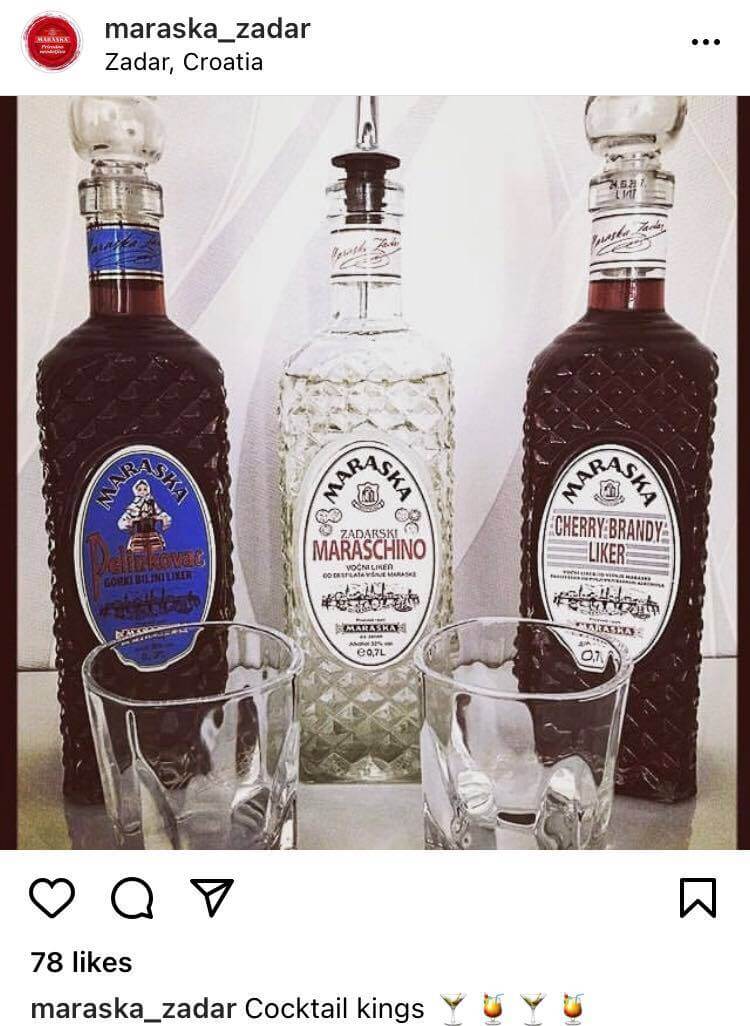
Photo credit: Instagram: maraska_zadar
Originating from Asia Minor, the maraschino cherries were brought to the Mediterranean during the time of the Roman Empire. The bitter-sweet Maraschino flavour is extracted from Marasca ripe sour cherries and their young leaves and is used for distillation. The Maraschino liqueur was even served on the tables of historical rulers such as Napoleon Bonaparte, George IV of the United Kingdom, and Emperor Nicholas of Russia. Many notable celebrities enjoyed the taste of Maraschinos including Alfred Hitchcock, G. B. Shaw, Ernest Hemingway, and Charlie Chaplin. It was also included in the list of stocks of the Titanic on its historically famous first and last voyage. Called "the king of all liqueurs", Maraschino liqueur makes a perfect souvenir. It can be found in almost any supermarket in Croatia, but for a nice gift-packaging, you can visit or buy online at the Maraska Store in Zadar.
Šibenik button
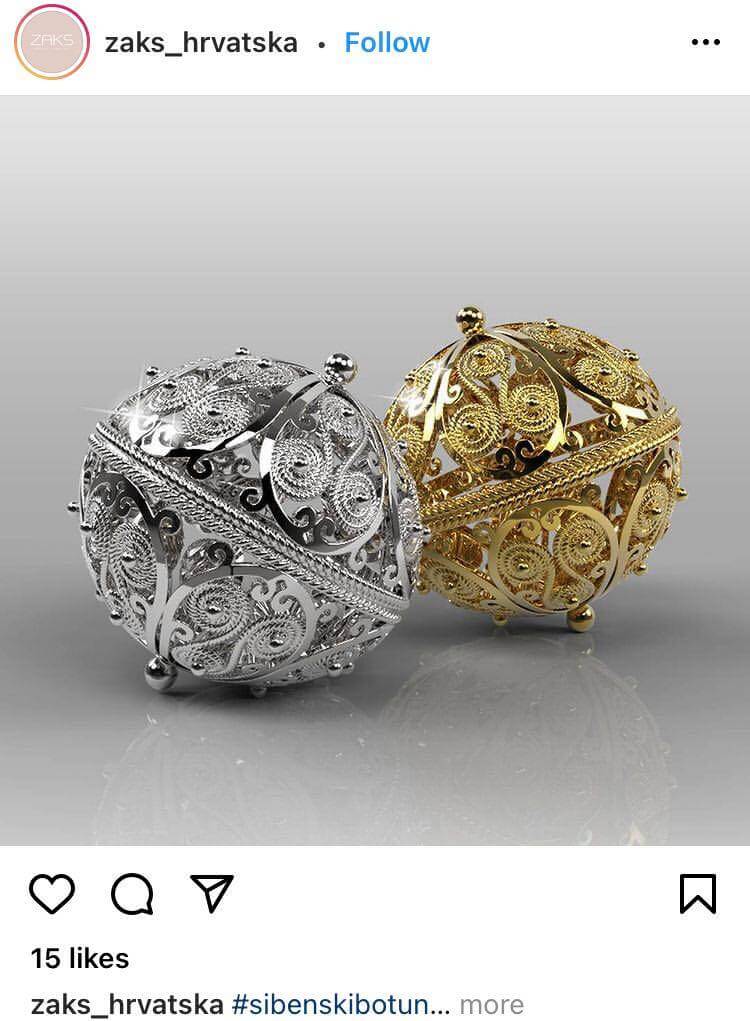 Photo source: Instagram: zaks_hrvatska
Photo source: Instagram: zaks_hrvatska
The Šibenski botun, as they call it in Croatia, was recognized by the Croatian National Tourist Board as the most original Croatian souvenir in 2007. Historically worn only by Croatian men, the buttons used to indicate the social status of the wearer and also had military implications because they were customarily given as gifts to commanders and heroes. The making of these buttons use the ancient filigree technique and used silver. Nowadays, the Šibenik buttons are now sold in gold and aluminum and come in different sizes and forms such as earrings, rings, necklaces, brooches, and bracelets in many Croatian jewelry shops. There is also other traditional Croatian jewelry you can buy all over Croatia - Zaks has an impressive list of authentic Croatian jewelry products for you to choose from!
Licitar Hearts
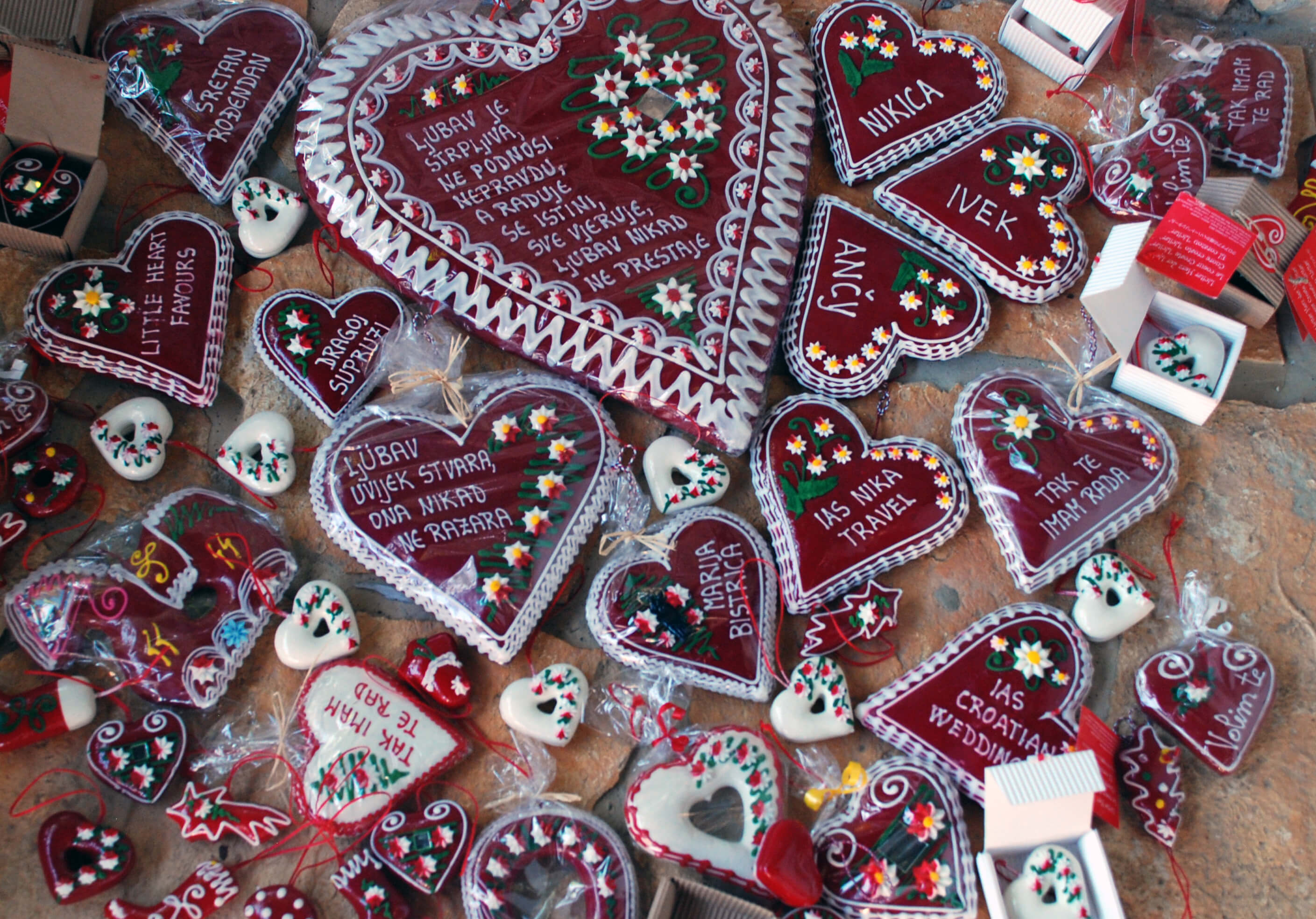 By Seanpu1 - Own work, CC BY-SA 3.0, https://commons.wikimedia.org/w/index.php?curid=11152088
By Seanpu1 - Own work, CC BY-SA 3.0, https://commons.wikimedia.org/w/index.php?curid=11152088
The most recognizable symbol of Zagreb, Croatia's capital city, is the Licitar Heart. This tradition dates back to the Middle Ages, all over Europe but usually in monasteries. They were famous souvenirs for pilgrims who buy them to remember their long and taxing journey to spirituality. These red hearts are completely edible, even though most people prefer them as decorations. The traditional way of making a Croatian Licitar is listed under UNESCO's Intangible Cultural Heritage because of the intense labour, time, and skills needed to make them - which, if traditionally prepared, can take more than a month at the very least. Nowadays, most people take shortcuts and the mass-produced licitars are rarely traditionally made. Licitar hearts are usually gifted on weddings adorned with the wedding date and the names of the newlywed and as a token of love for sweethearts on Valentine's Day. They also have now become popular Christmas ornaments.
Šestine Umbrella
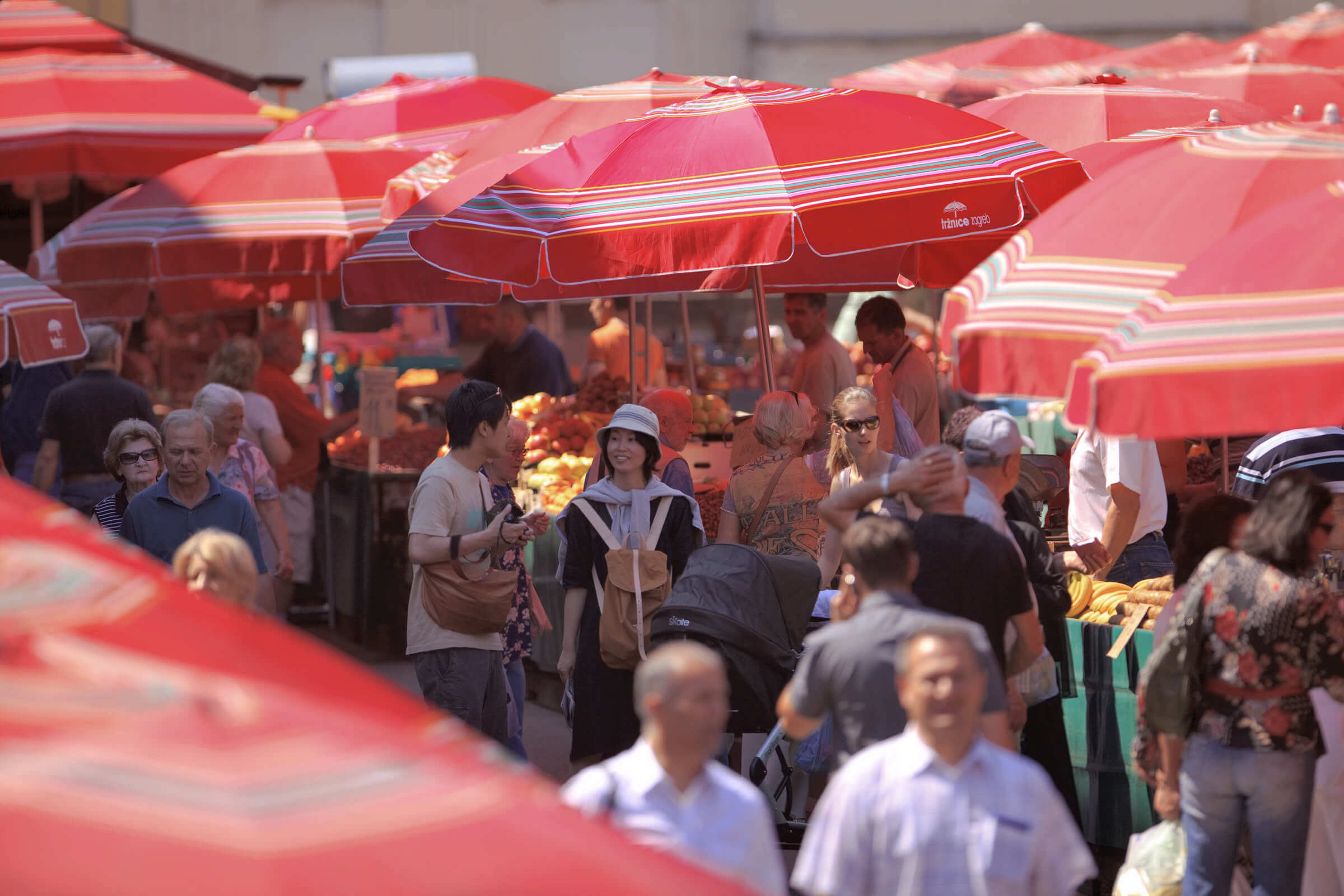 Šestine umbrellas at Dolac market, Zagreb | Photo credit: Mario Romulić
Šestine umbrellas at Dolac market, Zagreb | Photo credit: Mario Romulić
Another souvenir prominent in Zagreb, the umbrella is a part of the folk attire of the Šestine people who live on the slopes of Medvednica mountains in Zagreb. The costume was worn every day by the people in Šestine until the 1960s but nowadays, it is mostly worn at special events, ceremonies, and folklore festivals. The Šestine umbrellas are usually used as parasols at Zagreb's famous Dolac market. The umbrella is characterized by bright red striped canvas, a wooden rod, and a handle made of chestnut wood. This iconic umbrella of Zagreb has been gifted to well-known figures such as Former Prime Minister of the United Kingdom Margaret Thatcher and celebrity Robbie Williams. At present, the most famous manufacturer of authentic šestine handmade umbrellas is Cerovečki Kišobrani.
Lavender products
 Lavender products from Hvar Island | Photo credit: Mario Romulic
Lavender products from Hvar Island | Photo credit: Mario Romulic
Lavender is a beautiful, purple Mediterranean herb which blooms abundantly in the Dalmatian region of Croatia every summer. Although the main Croatian lavender growing region is the island of Hvar, it can be found almost anywhere in Dalmatia. A lot of souvenir shops sell lavender products such as dried lavender flower pouches which are good for repelling wardrobe moths and mosquitos, a lavender essential oil that is famous for its medicinal benefits such as treating wounds and its calming effect, and lavender soap, cream, and lip balm which are all good for various skin problems such as acne, burns and insect bites. In Dalmatia, lavender is also used in sweets most especially in ice cream - so do not forget to try one out!
Flower of Salt Nin

Photo source: Instagram: solana.nin
Ecologically produced and harvested by human hands, the Flower of Salt from Solana Nin is called "the caviar among salt". Nin Saltworks is found in a small town of Nin near Zadar and has been producing salt traditionally and sustainably for 1,500 years. Their product is a result of the perfect amalgamation of the sun, Adriatic sea, and the Bora wind from the Velebit mountain. It is named Flower of Salt because it appears on the surface of the sea like a thin layer of flower petals and is delicately harvested by hands. The salt is often not used in the cooking process but is added at the end as a final touch. Apart from heightening the taste of the dishes, salt enriches the body because it contains 75 minerals essential for human dietary needs. Solana Nin also sells Flower of Salt with other spices such as lavender, Dalmatian spices, truffles, and paprika. They also sell other souvenirs such as ceramic and wooden salt keepers, salt necklaces, even chocolates, and energy bars containing this special ingredient.
Croatian wine and rakija brandy
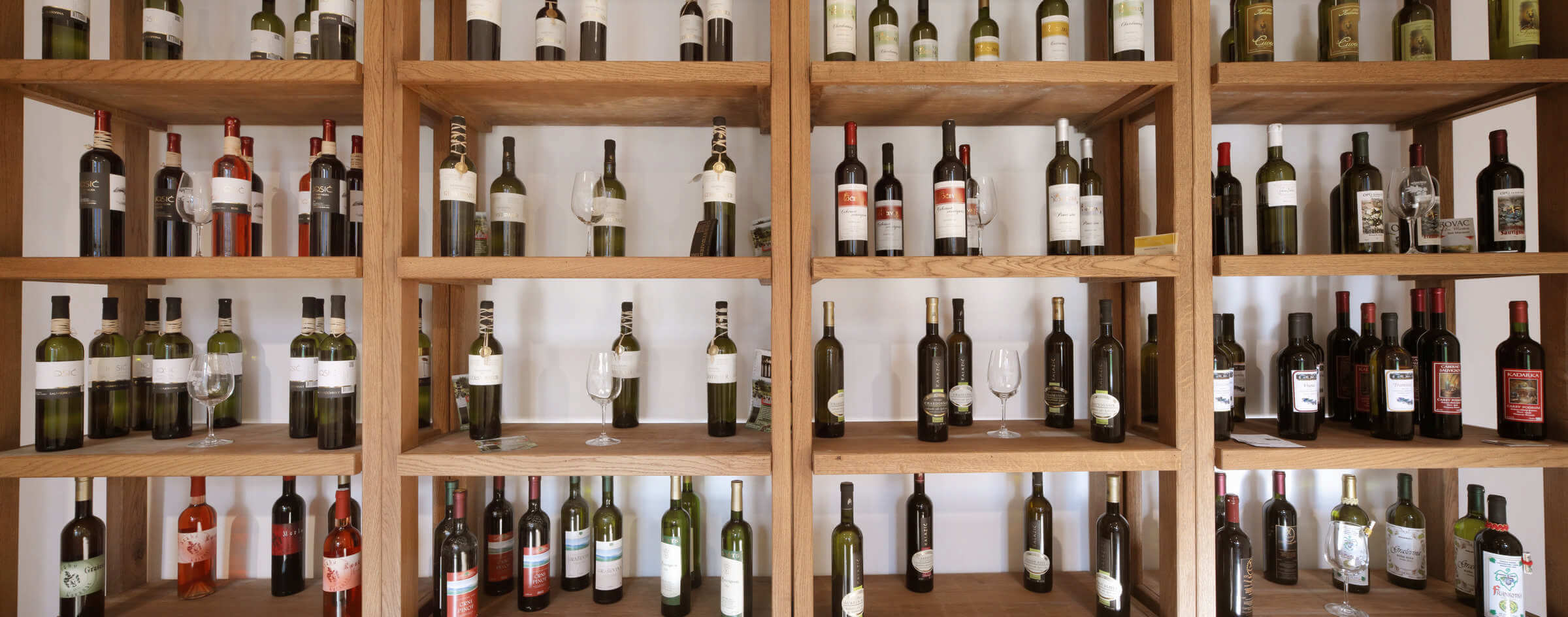 Photo credit: Mario Romulić
Photo credit: Mario Romulić
Croatia has A LOT of indigenous grape varieties so a bottle of Croatian wine makes a great souvenir to remind you of flavours and aromas uniquely found in Croatia. In Dalmatia, the most famous ones are the Vugava wine from Vis island, Pošip Wine, Rosé wines, and the red wine varieties - Plavac Mali, Babić, and Dingac. In Istria, a bottle of Malvasia is highly recommended and Graśevina is your top choice if coming from Slavonia. One of the best ways to buy Croatian wine is to visit a local winery and learn from the makers. Rakija is popular all over the Balkan region, especially in Croatia where locals also use it for cooking, cleaning, and different home remedies. Rakija is a fruit brandy, often made with honey, different herbs, and fruits, and usually served as an aperitif.
Croatian Chocolates
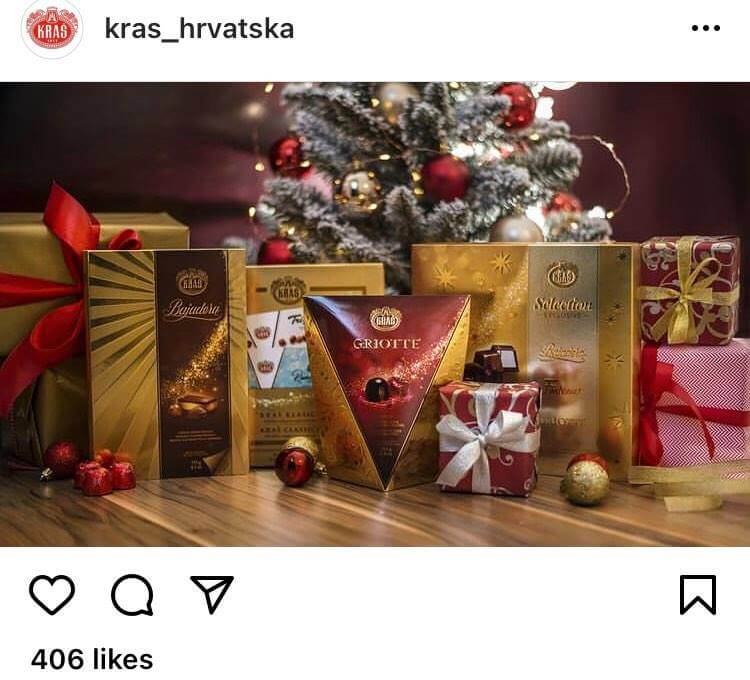
Photo source: Instagram: kras_hrvatska
Kraš is a Croatian chocolate factory that was founded in 1911 and is undoubtedly the best local brand of chocolates in Croatia. Kraš products are widely sold in every supermarket in Croatia. In Zagreb, Rijeka, and Opatija, you can buy Kraś chocolates in Kraš Choco Bar where they sell a wide assortment of chocolate products, chocolate drinks, cakes, ice cream, and pastries. The bestselling product is Bajadera, a layered nougat from almonds and hazelnuts. Kraš also has biscuits and wafers called Domačica, Jadro, and Napolitanke that are also loved by the locals. Other popular products include chocolate boxes Griotte, Fontana, Novela, Dorina Praline and Dragees, and chocolate bars Dorina and Čoksa.
Croatian olive oil
 Olives from Pag Island | Photo credit: Mario Romulić
Olives from Pag Island | Photo credit: Mario Romulić
Croatia ranks 7 in the Extra Virgin Olive Oil world ranking for countries with the best olive oil in the world but Croatia produces limited quantities of olive oil for exportation so do not miss the opportunity to bring home a bottle of local Croatian olive oil with you. Olive oil is widely used in Croatian and Meditteranean cuisine and most Croatian families grow olive trees and produce their own olive oil for family use. According to Tasteatlast, the best quality olive oil in Croatia are the ones from the islands of Šolta, Korčula, Cres, Krk, and the region of Istria. There is a lot of homemade olive oil the are sold in pazar (Croatia's farmer's market) and small shops all over Croatia, as well.
Croatian Cheeses
 By Isiwal / Wikimedia Commons / CC-BY-SA-3.0, CC BY-SA 3.0, https://commons.wikimedia.org/w/index.php?curid=32899504
By Isiwal / Wikimedia Commons / CC-BY-SA-3.0, CC BY-SA 3.0, https://commons.wikimedia.org/w/index.php?curid=32899504
Croatian cheeses have won several international recognitions and awards making them one of the best souvenirs in Croatia to take home with you. The most famous traditional Croatian cheeses include Pag cheese, inland Croatia's special Prga and Škripavac, and Sir iz mišine from the Dalmatian region of Croatia. The Pag cheese is highly regarded for its unique flavour and good nutritional content since it is made from the milk of sheep that graze solely on Mediterranean herbs and pastures which are full of salt from the sea that was carried on by the Bora wind in the island of Pag. Prgica, or Prga, is a specialty of the Bilogora-Podravina and Medimurje regions and is produced from fresh cow's milk that has been fermented for few days that was added with salt and spicy/sweet red paprika and is dried and shaped into cones. Škripavac is a traditional cheese produced in the region of Lika. Škripavac is the freshest cheese in Croatian cheeses because the raw cow's milk or sheep's milk is only strained and afterward heated enough to dissolve the rennin that coagulates it. Sir iz mišine is made from sheep's milk that is aged in mišina (lambskin sacks), which gives the cheese its distinct aroma and flavour. It is transported and sold in the same sack it aged in.
For more on travel in Croatia, follow TCN's dedicated page.
For more about Croatia, CLICK HERE.
Pension Insurees' Numbers Rising For Five Months in Row
ZAGREB, 6 July, 2021 - The Croatian Pension Insurance Institute (HZMO) said on Tuesday that the number of pension insurance contributions had been on the rise for five months in a row, and the number of insurees was higher by 3.54% at the end of this June compared to June 2020.
At the end of this June, the contributions were paid by 1,596,112 insurees, or by 54,499 people more than the year before.
Broken down by sector, the highest number of pension insurees was registered in the processing industry (more than 246,000 people covered by insurance contributions).
The rise in the number of insurees has been registered in several sectors, for instance, in construction, IT, the hospitality industry and so on.
For more about politics in Croatia, follow TCN's dedicated page.
€40m Transfer Technology Fund to be Established
ZAGREB, 6 July, 2021 - Investment in private equity in Croatia stands at 0.3% of GDP, whereby it lags behind the most successful countries in that segment, the Croatian Bank for Reconstruction and Development (HBOR) CEO said on Tuesday, adding that the HBOR would participate in launching a €40 billion technology transfer fund.
Tamara Perko was speaking at the Bestinvest.hr conference organised by the Croatian Private Equity and Venture Capital Association, at which awards for the best private equity and venture capital investment were presented.
Perko said the HBOR contributed significantly to the development of private equity and venture capital in the past two years.
She said that together with the European Investment Fund (EIF) and private investors, the HBOR invested in €46 million worth FIL Rouge Capital, the first venture capital fund investing only in Croatia.
Last year the HBOR, together with the EIF, established three more equity funds in Croatia, the Prosperus Growth Fund, the Adriatic Structured Equity Fund, and the Croatian Mezzanine Debt Fund, investing over €80 million.
Perko said that together with the EIF and the Slovenian development bank, the HBOR planned to invest in a fifth fund, the Transfer Technology Fund. In terms of patents, Croatia is within the EU average, but is near the bottom when it comes to their applicability in the economy, she added.
The purpose of the Transfer Technology Fund is to commercialise science and finance societies that will be established in science and research institutions and work together with the economic sector by providing the necessary products, services and processes, Perko said.
She said that Estonia invested 1.3% in private equity and was among the countries investing the most in that segment, adding that Croatia, with only 0.3%, "must run four times faster to catch up with the best."
Minister underlines importance of industries based on new technologies
Economy and Sustainable Development Minister Tomislav Ćorić underlined the importance of technology transfer and new technologies for the Croatian economy whose development, he said, must be based on those industries.
He said the venture and private equity scene in Croatia developed in a good direction over the past ten, 15 years. The fact that classic financing sources often are not enough additionally underlines the importance of the fund industry, he added.
For more about politics in Croatia, follow TCN's dedicated page.
Bill Regulating Family Pension Beneficiaries' Status on Parl. Agenda
ZAGREB, 6 July, 2021 - The Croatian Pension Insurance Institute (HZMO) said on Tuesday that the number of pension insurance contributions had been on the rise for five months in a row, and the number of insurees was higher by 3.54% at the end of this June compared to June 2020.
The government-sponsored amendments were forwarded to the parliament at the session of the Andrej Plenković cabinet on 1 July.
In May, there were 216,000 family pension beneficiaries, and most of them were surviving spouses whose average monthly pension allowance was HRK 2,096, which was below the average pension. For instance, in May, pension associations reported that the average pension paid out for February stood at HRK 2,567.
The budget allocation for this purpose has been ensured for 2022 and 2023.
According to the government's estimates, this year, an estimated 1,100 recipients of family pensions can exercise this right to work part-time and continue receiving family pensions. In 2022, the numbers can rise to 3,200 and in 2023 to 4,100 beneficiaries.
(€1 = HRK 7.484635)
For more about politics in Croatia, follow TCN's dedicated page.
Marjan Kustić Officially Nominated for HNS President, Šuker Out After 9 Years?
July 6, 2021 - Davor Šuker's 9-year stint as HNS president will last until July 29, with Marijan Kustić likely to take over the leading role in the Croatian Football Federation.
Namely, Marijan Kustić was nominated for the president of HNS by his county union, and judging by the photo coming from Lika-Senj County, at least 18 of the 21 county unions gave him support. Considering that the Zagreb Football Association president, Tomislav Svetina, who was the only one who could nominate Davor Šuker, is also in this picture, it is evident that this candidacy will not take place. Even if the ZNS wanted to nominate Šuker, it would not be able to because it officially needs the support of at least seven county unions, reports Sportske Novosti.
Kustić was also supported by Ante Vučemilovi-Šimunović from Osijek, as well as the dismissed chief referee Ante Kulušić on behalf of the Šibenik-Knin County. Thus, it can be said that the photo from the Lika-Senj Association reveals the future of Croatian football, with Marijan Kustić in the lead role.
The Lika-Senj County Association announcement is transmitted in its entirety:
"At yesterday's Assembly session in Gospić, in the presence of all its members, the Lika-Senj County Football Association supported the candidacy of its county president Marijan Kustić for the president of the Croatian Football Federation by acclamation.
In addition to members of the Lika-Senj County Football Association, the assembly was attended by the presidents of 17 county football associations in Croatia.
This is also the first official nomination for the top position of the Croatian Football Federation.
After the election, Marijan Kustić thanked all members of the Assembly for their tremendous support, but also all the presidents of the county football federations who increased the presidential candidacy of the current executive director of HNS and the president of the Lika-Senj County Football Association.
After this nomination of the parent county federation, Kustić will gather support from at least six more county football federations in the next few days to become official for his candidacy for president of the HNS.
The election assembly of the Croatian Football Federation will be held on July 29 this year in Zagreb," the statement said.
To follow the latest sports news in Croatia, follow TCN's dedicated page.
To learn more about sport in Croatia, CLICK HERE.
Von der Leyen to Visit Zagreb Thursday after European Commision Okays Croatia's Recovery Plan
ZAGREB, 6 July, 2021 - Prime Minister Andrej Plenković said on Monday that the European Commission's President Ursula Von der Leyen would arrive in Zagreb on Thursday after the European Commission approved Croatia's national recovery and resilience plan.
President von der Leyen has decided to personally deliver the national recovery and resilience plan to each of the 27 member states.
PM Plenković said that the green-light to Croatia's €6.3 billion recovery plan was an important encouragement.
"We are satisfied with the finalisation of the process before we expected," Plenković said on Monday evening.
In early June, Croatia and another four EU member-states -- Slovenia, Poland, Sweden and Romania -- asked the European Commission to extend a deadline for the assessment of their national recovery and resilience plans.
The EC had two months to assess these plans that set out the reforms and public investment projects that each Member State plans to implement with the support of the Recovery and Resilience Facility (RRF).
The rules envisage that member-states can request a reasonable extension of time for the assessment of national recovery and resilience plans after the documents are submitted.
The Commission received Croatia's plan on 15 May, and Zagreb "has requested a total of almost €6.4 billion in grants under the RRF", the EC says on its website.
The Croatian plan is structured around five components: green and digital economy, public administration and judiciary, education, science and research, labour market and social protection, healthcare. It also encompasses one initiative on building renovation.
The plan includes measures to improve business environment, education, research and development, energy-efficiency in buildings, zero-emission transport and the development of renewable energy sources.
Projects in the plan cover the entire lifetime of the RRF until 2026. The plan proposes projects in all seven European flagship areas, the EC added.
For more about politics in Croatia, follow TCN's dedicated page.
Croatia's Coronavirus Update: 96 New Cases, Two Deaths, 65 Recoveries
ZAGREB, 6 July, 2021 - In the last 24 hours, of 5,103 tests performed for coronavirus in Croatia, 1.9%, that is 96, have turned out to be positive, the national COVID-19 crisis management team stated on Tuesday.
Currently, there are 528 active cases, including 132 hospitalised patients, of whom 10 are placed on ventilators.
In the last 24 hours, the COVID-related death toll has risen by two to 8,221.
Since the first registered case of the infection with this novel virus in Croatia on 25 February 2020, as many as 2,171,883 tests have been performed showing that 360,342 people have contracted the virus. Of them, 351,593 have recovered so far, including 65 recoveries in the last 24 hours.
The Croatian Public Health Institute (HZJZ) reported on Tuesday that 37.3% of the total population or 45% of the adult population had been vaccinated to date.
A total of 2,687,515 doses of COVID-19 vaccines have been administered to date.
For more about COVID-19 in Croatia, follow TCN's dedicated page.
Celebrate Nikola Tesla On His 165th Birthday This Weekend in Gospić
July 6, 2021 - This Saturday marks the 165th anniversary of the birth of the genius born in Smiljan, and the Tourist Board of Gospić, the city of Gospić, and the Nikola Tesla Memorial Center have prepared a worthy event called ''Tesla Power of Lights'' to celebrate Nikola Tesla in style.
Turističke priče reports that as part of the celebration of the 165th anniversary of the birth of Nikola Tesla on July 10th, a lot of content was prepared that will serve as a kind of reminder of the fact that one of the world's greatest geniuses, Nikola Tesla, was born in Lika. On his birthday, this Saturday, as part of the July program in Gospić, the event "Tesla Power of Lights" will be held.
It is a one-day event to celebrate Nikola Tesla, organized by the Tourist Board of the City of Gospić, the City of Gospić, and the Nikola Tesla Memorial Center, and the program will be held in the evening. This year, a light spectacle will be organized in Gospić and its surroundings, and citizens and visitors will be able to enjoy a laser show, among other things. In addition to the extraordinary light effects that will spread the sky over the city, the program of the celebration also includes a multitude of contents on the main city square.
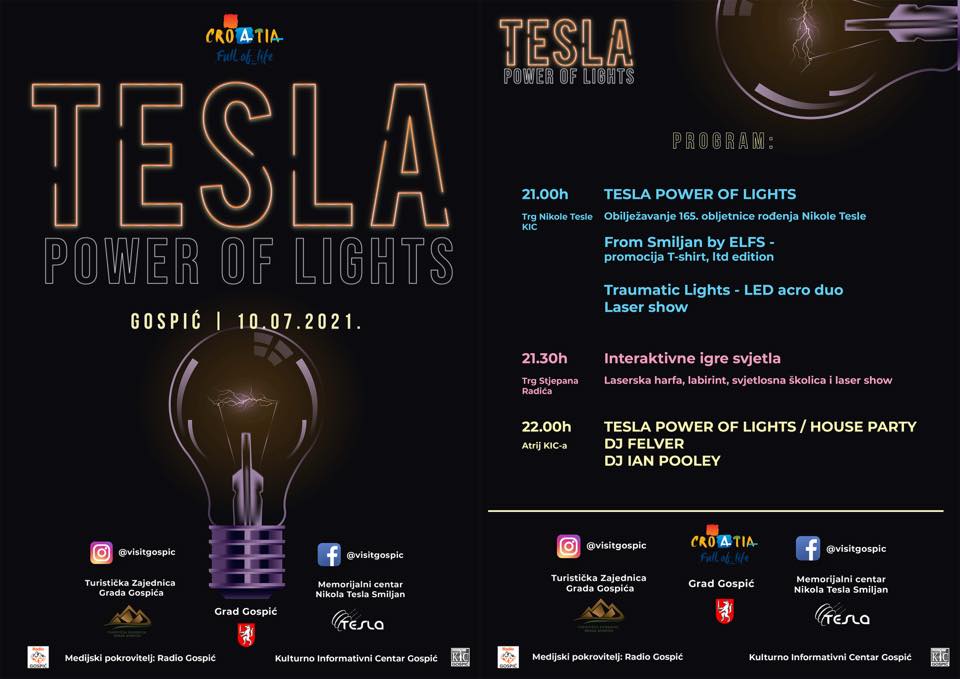
Gospić Tourist Board Facebook Page
Thus, Interactive Games of Light, Laser Harp, Light Labyrinth… will be held on Stjepan Radić Square, and part of the “Tesla Power of Lights” program will also take place on the newly built Nikola Tesla Square. At 9 pm, in the Atrium of the Cultural Information Center Gospić, there will be a promotion of T-shirt From Smiljan by ELFS and Traumatic Lights - Led acro duo, followed by a House party that will start at 10 pm. DJ Felver and DJ Ian Podley will perform.
Under the colored light beams will be buildings related to the life of Nikola Tesla in Gospić, and the Nikola Tesla Memorial Center in Smiljan, which includes the birthplace of the great inventor, physicist, and inventor, will have an Open Day on July 10.
Total Croatia included Nikola Tesla in its guide to Croatian inventions and discoveries, which you can read HERE.
For more news about everything made in Croatia, be sure to follow TCN’s dedicated page.
HNK Gorica and Zagreb County Tourist Board Join Forces
July 6, 2021 - HNK Gorica and Zagreb County Tourist Board have joined forces. The tourist board has thus become a new member of the family of partners of this ambitious first league football team.
Although football in Croatia is far from a real marketing product, the whole league is rising from year to year and thus gaining in attractiveness. On the other hand, HNK Gorica is one of the "stars" of the Croatian Football League (HNL), which has a bright future ahead of it, reports HRTurizam.
"It is often forgotten that football clubs have three categories that travel every week during the season (some play at home, while others travel to away matches), and thus achieve overnight stays in each destination. Whether they are seniors, juniors, or other categories, everyone travels to matches and has to spend the night somewhere. Our goal is to point out the potentials of sports tourism and its role in the development of overall tourism," said Ivana Alilović, director of the Zagreb County Tourist Board and added:
"Tourism is an important component of our economy and the situation with Covid-19 has shown us that we need to think in the other direction. HNK Gorica is one of the key drivers of sports life in Velika Gorica and Zagreb County. Still, it is also one of the key carriers of our accommodation capacities in the entire county. Therefore, we must support such a club in activities, in every opportunity to attract teams from various countries to our area. We are extremely grateful for everything they have done in this segment of ours."
Ervin Kolarec, Deputy Prefect of Zagreb County, also came to support this cooperation. “HNK Gorica is a great promoter of both its city and our county, which is why I am thrilled that the club has connected with our tourist community. Since, among other things, more than 450 children are active in this club, the Zagreb County will be with HNK Gorica in the future as well," said Kolarec.
The cooperation between the club and the county tourist board will be mutual, diverse, and possibly a bit unusual. ”We will look in some new directions, which will allow us some new types of promotion of our region. For example, why wouldn't HNK Gorica do one of its trainings at Turopoljski lug? Is there anything nicer?" suggested Ivana Alilović.
Football clubs are an excellent medium for communicating the tourist offer and additional content for all visiting teams coming to the destination. Football is one of the best marketing media globally, and even the Croatian National Tourist Board is a sponsor of the Croatia national football team.
To follow the latest sports news in Croatia, follow TCN's dedicated page.
To learn more about sport in Croatia, CLICK HERE.
For more on travel in Croatia, follow TCN's dedicated page.


